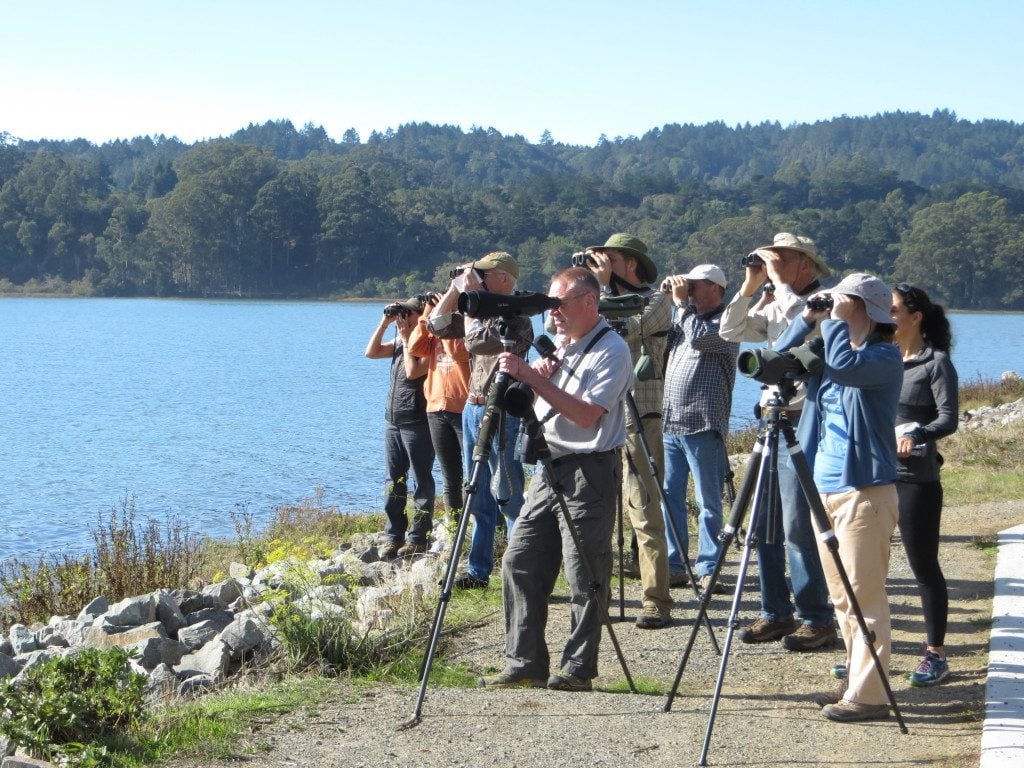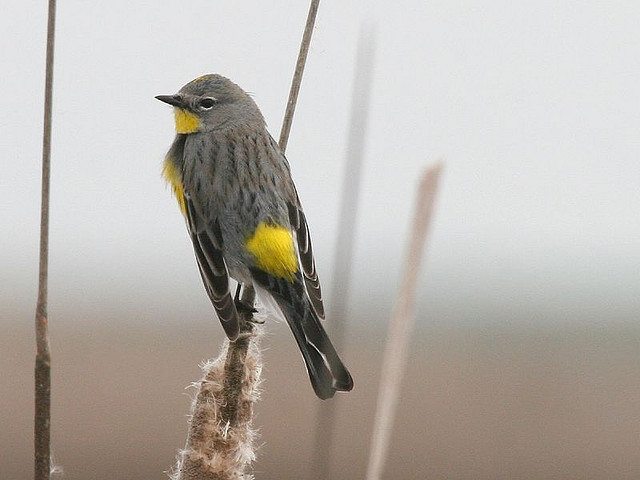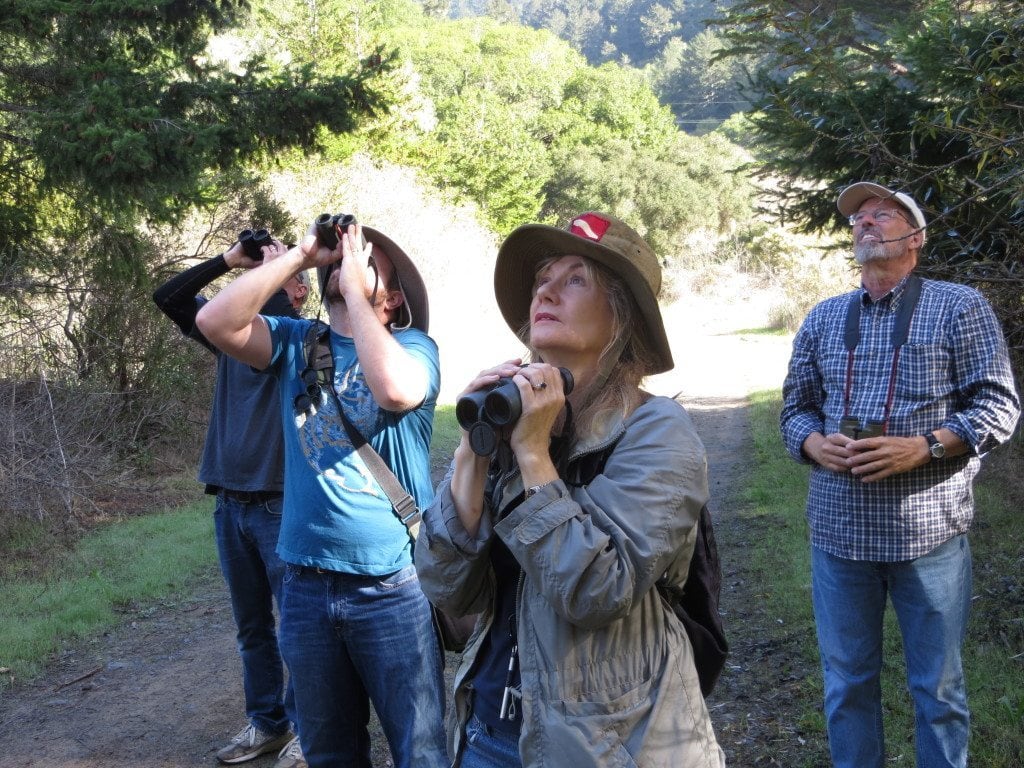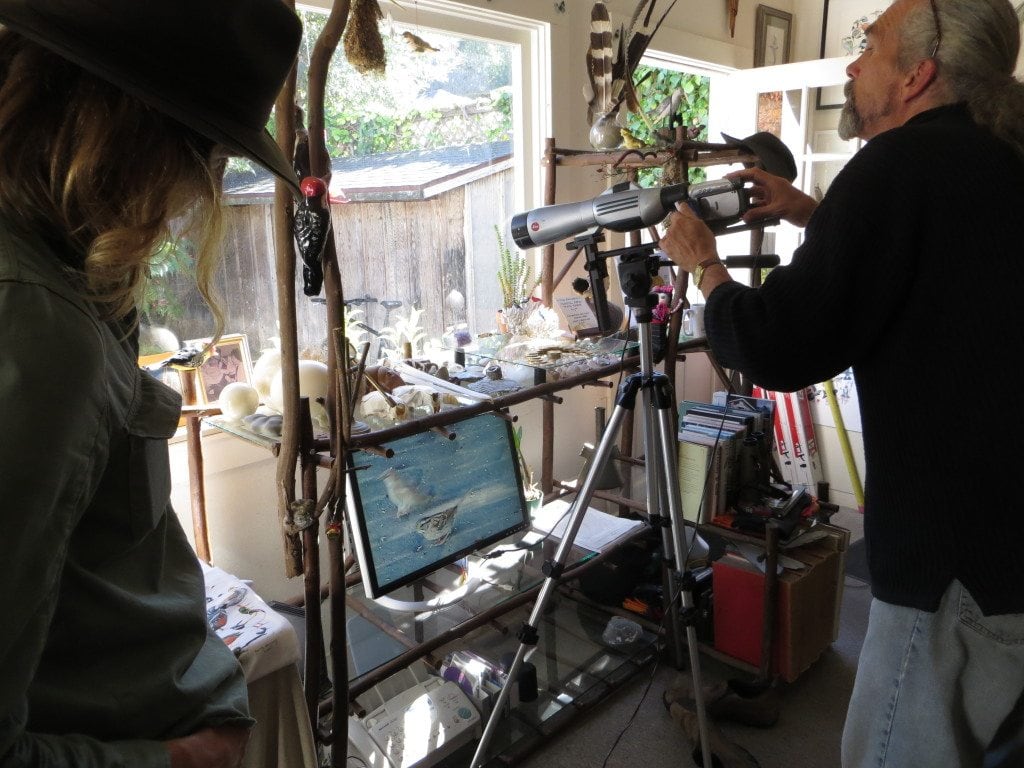Master Birder class opens eyes, enhances skills
By Ilana DeBare
Most of the beachgoers hurried obliviously through the parking lot, intent on reaching the sand and the waves. But for one group of about 20 people, the parking lot was the main attraction.
There in the Monterey pine! Those little dark shapes that looked like pine cones! Through a scope, they were in fact Cedar Waxwings. And just a little further on, the willows were filled with Yellow-rumped Warblers, Townsend’s Warblers, Ruby-crowned Kinglets….
This was the next-to-last field trip of the year for the Master Birder class co-sponsored by Golden Gate Bird Alliance and California Academy of Sciences – a mid-November trip to Stinson Beach, Bolinas Lagoon, and the amazing studio of bird artist Keith Hansen.
For the twenty Master Birder participants, the advanced year-long class involved much more than being able to spot warblers and waxwings. Over the course of 2014, they:
- Chose a local birding “patch,” visited it at least twice a month, and kept a field notebook of their findings.
- Examined and handled dozens of bird specimens from the Academy’s collections.
- Learned about bird anatomy, evolution, behavior, and calls, as well as habitats and plants associated with different birds.
- Wrote descriptions and personal observation of three different bird species.
- Delivered a ten-minute talk on an aspect of birds or ornithology.
- Took part in over 20 field trips
- Led a field trip themselves – often for the first time!
- Volunteered over 100 hours for a conservation organization.
It sounds daunting. But participants said the class was one of the high points of their lives as birders.


“I’ve taken a lot of Audubon classes, and in this one, the content is really broad and detailed,” said Rachel Davidson. “Having it spread out over the course of a year solidifies your understanding.”
“The lectures were amazing,” said Jane Hart. “Bob talked about what produces color on birds, Eddie talked about changes in the Bay Area landscape since early geological time, and Jack talked about migration. It just makes you want to learn.”
Hart was referring to the class’s three co-instructors – GGBA board member Bob Lewis, naturalist Eddie Bartley, and Cal Academy curator of birds and mammals Jack Dumbacher.
2014 was the second year that the three of them had taught the class. (NOTE: They will be teaching it again this year, starting in February. For details, see our Classes web page.)
The class had been a longtime dream of Bob Lewis and other GGBA birding instructors.
“For quite a few years in our Adult Education committee, we’d talked about a Master Birder class,” Lewis recalled. “We knew there were Master Gardeners. Why not Master Birders? Then Jack (Dumbacher) joined the GGBA board and said, ‘Yeah, let’s do that.’”
The partnership with California Academy of Sciences allows the class to draw on both Jack’s ornithological expertise and the museum’s world-renowned collections.
“Eddie and I thought, ‘Boy, have we lucked into something really good here!” Lewis said. “It was kind of a too-good-to-be-true event.”

In planning the class, the instructors realized that their goal was not just creation of better birders, but development of future field trip leaders, volunteers, and activists.
“We try to give them the tools to be effective,” Lewis said. “It’s not just bird knowledge, but knowledge of organizations promoting conservation, an ability to speak publicly, and awareness of field tools like Breeding Bird Surveys, eBird, and population surveys. We hope to lead them down the path to being rabid conservationists.”
On this particular November day, the path to rabid conservationism led the Master Birders through Keith Hansen’s studio in Bolinas. Along with his painting supplies and work desk, Hansen has a video camera trained out the window into a small yard with twelve (!) hummingbird feeders. The Master Birders eagerly interrogated Hansen about the set-up, which included a video screen showing live close-ups from across the yard.
His yard list totals 274 species – one of the highest yard lists in the country. One day he counted 68 Anna’s Hummingbirds in the yard at one time. He goes through a gallon of nectar per day.

It was a fitting end to a great morning of shore, meadow, lagoon, and parking lot birding…. and just another eye-opening moment in a year of Master Birder encounters.
“The Cal Academy specimens made identifying Greater and Lesser Scaup easier,” said Whitney Mortimer. “The specimens are huge, so you start to see the size differential and the big nail on the end of the bill. It’s the next best thing to having the bird in your hand.”
“I used to go out and count species, but now I look more carefully at each bird,” said Ralph Pericoli. “I notice the head, tail, back, wings. The class got me to really focus.”
—————————————————–
There are still spaces available in the 2015 Master Birder class, which starts on Wednesday, February 4. Participants must be intermediate-level birders (100+ species by sight, and 25+ species by sound). For information, see goldengatebirdalliance.org/education/classes/. For additional information and to apply for the class, see the California Academy of Science web site.
